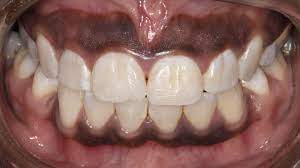Black gums can be a cause for concern as they can indicate underlying health issues. While it’s normal for the gums to be pink, black gums can be a sign of various oral health problems. Dark gums can result from various causes, including genetics, smoking, medication, or underlying health issues. It is important to identify the root cause and seek appropriate treatment to prevent further damage. In this post, we will explore the causes of black gums, common treatments, and prevention methods. Understanding black gums can help you maintain good oral health and overall wellness.
Introduction to black gums and their significance
Black gums, though not commonly discussed, can be a cause of concern for many individuals. While gums typically have a pink or coral color, the presence of black gums can be alarming and may indicate underlying issues. Understanding the causes, treatments, and prevention methods related to black gums is crucial in maintaining optimal oral health.
The significance of black gums lies in their potential association with various oral health conditions. In some cases, black gums may be a natural occurrence, particularly in individuals with darker skin tones. This is due to a higher concentration of melanin, the pigment responsible for skin and hair color, in the gum tissue. However, it is important to differentiate between natural pigmentation and discoloration caused by underlying problems.
Black gums can also be an indicator of certain medical conditions, such as oral melanoma or certain types of gum disease. These conditions require immediate attention and professional intervention to prevent further complications. Furthermore, habits such as smoking or tobacco use can lead to the blackening of the gums, emphasizing the need to address such behaviors.
Common causes of black gums
Black gums can be a cause for concern and often lead individuals to seek answers about their underlying causes. While some cases of black gums may be harmless, it is essential to understand the common causes to determine the appropriate course of action.
One of the most common causes of black gums is melanin pigmentation. Melanin is responsible for the color of our skin, hair, and gums. Some individuals naturally have higher levels of melanin in their gums, resulting in a darker or black appearance. This is typically a harmless condition known as racial pigmentation and does not require any treatment.
Another common cause of black gums is smoking or tobacco use. The chemicals present in cigarettes can lead to pigmentation changes in the gum tissue, causing it to darken over time. This is often accompanied by other oral health issues, such as bad breath and an increased risk of gum disease. Quitting smoking is not only crucial for overall health but can also help prevent further discoloration of the gums.
The role of poor oral hygiene in the development of black gums
Poor oral hygiene plays a significant role in the development of black gums. When oral hygiene is neglected, plaque and tartar can accumulate along the gum line, leading to a host of oral health issues. One of these issues is the discoloration of the gums, which can appear black or dark brown.
Plaque, a sticky film containing bacteria, can easily build up on the teeth and gums if proper brushing and flossing techniques are not followed. When plaque is not removed regularly, it hardens into tartar, which can irritate and inflame the gums. This condition, known as gingivitis, can cause the gums to become red, swollen, and tender. In some cases, the gums may darken in color, presenting as black gums.
Furthermore, poor oral hygiene can also contribute to the development of gum disease, also known as periodontal disease. As gum disease progresses, it can lead to more severe discoloration of the gums, including black spots or patches. This is a result of the gums pulling away from the teeth, forming pockets where bacteria thrive and cause further damage.
Smoking and its impact on gum health
Smoking is not only detrimental to your overall health but also has a significant impact on your gum health. The harmful chemicals present in tobacco smoke can cause numerous oral health problems, including black gums.
One of the most common effects of smoking on gum health is a condition called smoker’s melanosis. This condition leads to the darkening of the gums, giving them a black appearance. The nicotine and tar present in cigarettes can cause pigmentation changes in the gum tissue, resulting in this unsightly discoloration.
Furthermore, smoking reduces blood flow to the gums, impairs the immune system’s ability to fight infections, and slows down the healing process. This means that smokers are more susceptible to gum diseases such as periodontitis, which can further contribute to the darkening of the gums.
Medications and their association with black gums
Medications can play a significant role in the discoloration of gums, causing them to appear black or darkened. Certain medications have been linked to this side effect, and it’s essential to understand the potential impact on your oral health.
One common class of medications associated with black gums is minocycline, an antibiotic often prescribed for acne treatment. Minocycline can cause a condition called oral pigmentation, leading to the darkening of gums. This pigmentation occurs due to minocycline binding to melanin-producing cells in the gums, resulting in a change in their color.
Other medications, such as antimalarial drugs, antipsychotics, and certain chemotherapy medications, have also been known to cause gum discoloration. These medications can affect the pigmentation process in the gums, leading to a darkened appearance.
Potential dental procedures that can lead to darkening of the gums
While black gums can be a natural variation in some individuals, certain dental procedures can also lead to darkening of the gums. It’s important to be aware of these procedures and their potential effects on gum color.
Gum grafting: Gum grafting is a common procedure used to treat receding gums. During this procedure, healthy gum tissue is taken from one area of the mouth and transplanted into the receding areas. In some cases, the color of the grafted tissue may differ from the surrounding gums, leading to a darkened appearance.
Dental implants: Dental implants are a popular option for replacing missing teeth. However, in some cases, the metal post of the implant can become visible through the gums, causing a darkening effect. This can be more noticeable in individuals with thin gum tissue.
Conclusion
The topic of black gums encompasses various factors, ranging from natural pigmentation to potential health concerns. While darkening of the gums can be a result of genetics or ethnicity, individuals must monitor changes in gum color and consult with dental professionals if they observe any unusual signs. Maintaining good oral hygiene practices, such as regular brushing, flossing, and dental check-ups, is essential for overall gum health. Understanding the causes and potential implications of black gums contributes to a proactive approach in addressing any underlying issues and ensuring a healthy oral environment. Ultimately, an informed and attentive approach to oral care is key to promoting not only aesthetic satisfaction but also long-term gum health.









